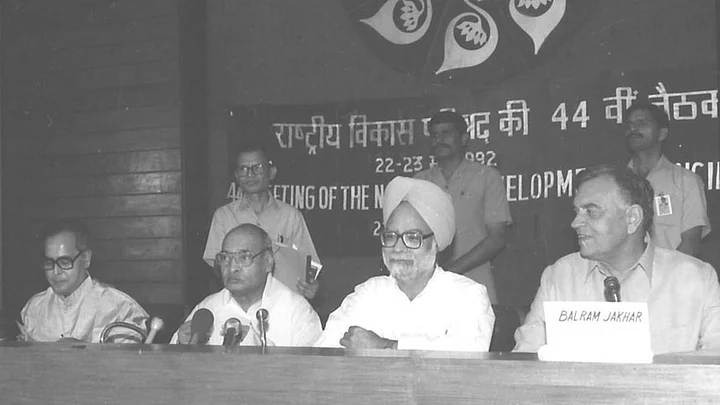(This article was first published on 28 June 2015. It is being reposted from The Quint’s archives to mark the birth anniversary of former Prime Minister PV Narasimha Rao.)
Pamulaparti Venkata Narasimha Rao, the first prime minister of India to have emerged from south of the Vindhyas, in 1991, passed unheralded in Delhi in 2004.
PV was a complex man, an autodidact, who taught himself to read and write in several Indian languages: Marathi, Kannada, Urdu, his native Telugu – and English, French and German.
Despite winning five elections before 1991, he was the quintessential backroom guy, holding many important portfolios in Congress regimes, respected for his pouting silences, interpreted as sagacity.
By 1991, aged 70, he had hung up his political chappals when Rajiv Gandhi’s assassination turned the tide in his favour. Squabbling Congress satraps, buoyed by a poll victory that was just short of majority, chose Rao to head the party and government.
With a 500,000 victory margin in 1991 in Nandayal, Rao was thought safe enough to become a puppet for Congress satraps like Sharad Pawar, Arjun Singh, N D Tiwari and others, who wanted Rao as a puppet-PM. They were wrong.
Rao’s legacy can be broken down into four parts: the liberalisation of India’s economy, increased squabbling within the Congress party, graft, and the demolition of the Babri masjid on December 6, 1992, which eventually led to the BJP seizing power in the late 1990s.
The Father of India’s Economic Reforms
On 24 July 1991, Finance Minister Manmohan Singh is supposed to have presented India’s first ‘reformist’ budget at 5 PM in Parliament. That is not the real story. Singh was not Rao’s first choice for finance minister.
Our economy was then wrecked by a balance of payments crisis, heightened by spiralling oil prices after the first Gulf War.
Rao’s first choice was economist IG Patel, then at the London School of Economics. He turned down the offer and suggested that Rao call Singh, then languishing as head of the University Grants Commission, to take over at North Block.
Thus, the legend of Singh as the original reformer began. But six hours before Singh’s Budget speech, Rao, who held the post of industry minister, called a discreet press conference. During the few minutes that he spoke, Rao dismantled the ‘licence-permit Raj’ that had stifled the economy for decades, while making a few privileged folks obscenely wealthy.
Rao was the father of India’s reform, not Singh. Rao also encouraged the opening up of India’s capital markets, the creation of the National Stock Exchange and the empowerment of market regulator SEBI.
That said, the rest of his legacy is murky.
Political Manipulation
Early on, he was accused of buying off MPs from parties like the Jharkhand Mukti Morcha. Lawsuits couldn’t nail him personally.
By 1992, with animal spirits soaring, an operator called Harshad Mehta got into the act, exploiting loopholes in India’s banking system to pour vast amounts of money in equity markets to prop up stocks of his choice. Mehta was charged with dozens of criminal offences and convicted in one, but died at age 47 in 2001.
By the time he was exposed, Mehta made a startling claim: In 1993, he and his brother had carted Rs 1 crore (a great deal of money at the time) to Rao’s residence. In a bizarre press conference, Mehta demonstrated how to pack Rs one crore in medium-denomination currency notes into a suitcase.
Rao worked the divide-and-rule policy to unseat his detractors.
During his era, Congressmen like Arjun Singh, ND Tiwari, GK Moopanar were shunted out. Palaniappan Chidambaram also chose the exit route, joining Moopanar’s Tamil Maanila Congress.
The Babri Masjid Debacle
Rao’s worst legacy was his handling of the Babri Masjid crisis, culminating in the demolition of a 15th century mosque by saffronites on 6 December 1992, while it’s said, Rao snoozed after lunch.
Before his death, Rao wrote a book called Ayodhya, December 6, 1992 instructing his publishers to release it at least a year after his death. There, he blames everyone but himself for the demolition. It led to rioting and mass killings across India and a reprisal in the Mumbai blasts of 1993. 6 December 1992 communalised India for all time.
Rao says sadhus and saints stabbed him in the back. He blames Congress colleagues, arguing that they led him up the path to demolition and chaos. But his defence doesn’t wash.
With his prime ministerial powers, he could have removed the BJP sarkar in Uttar Pradesh, imposed Emergency powers in Ayodhya, where the destruction took place, mobilised Central troops to protect the monument. He did nothing.
By 1994, with inflation peaking at 12 percent, Rao’s reforms were dead in the water. He bided time, lost the polls and became a pariah in his party. Ironically, the BJP worships him now for ‘allowing’ the Babri demolition to take place.
A man is judged by his actions and its effects on others. Despite his linguistic and manipulative abilities, the overall verdict on Rao can’t be positive.
(At The Quint, we question everything. Play an active role in shaping our journalism by becoming a member today.)
